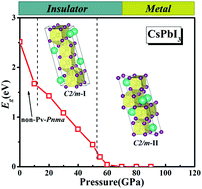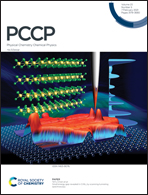Pressure effects on the structures and electronic properties of halide perovskite CsPbX3 (X = I, Br, Cl)†
Abstract
Cesium lead halide perovskites as ideal photovoltaic and optoelectronics materials have attracted more and more attention. Here, we investigated the structure and electronic properties of halide perovskite CsPbX3 (X = I, Br, Cl) by particle swarm optimization and first principles methods at hydrostatic pressure. For CsPbI3, the structure phases and corresponding phase transitions of non-perovskite orthorhombic Pnma (non-Pv-Pnma), monoclinic C2/m (C2/m-I), and another different monoclinic phase C2/m (C2/m-II) are found in the pressure range 0–120 GPa. The largest piezochromic effect in the perovskites can be predicted in CsPbI3 under a pressure below 10 GPa. The band gap is reduced under pressure and the C2/m-II phase becomes a metal under pressures larger than 65 GPa. For CsPbBr3 and CsPbCl3, the same phase sequence under pressure, i.e. from perovskite Pnma (Pv-Pnma), to non-Pv-Pnma, C2/m-I, and then to another orthorhombic Cmcm phase, is found. The newly discovered non-Pv-Pnma phase gives an excellent explanation of previous measurements at low pressure for CsPbBr3 and CsPbCl3. Furthermore, the calculations of electronic properties show that pressure is an effective means to tune the band gap. Our calculations and results extend the applications in photovoltaics and optoelectronics of halide perovskites.



 Please wait while we load your content...
Please wait while we load your content...